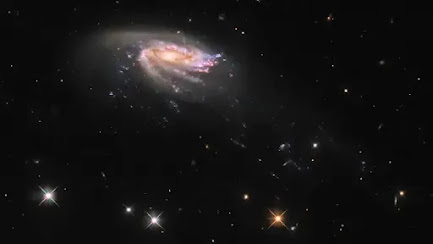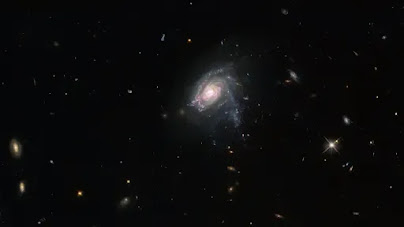NASA's Hubble Captures Stunning Image of Jellyfish Galaxy JO206
NASA's Hubble Space Telescope has once again mesmerized us with a captivating image, this time revealing the beauty of the jellyfish galaxy JO206. Located in the Aquarius constellation, JO206 resides over 700 million light-years away from Earth. Its striking resemblance to its aquatic counterpart earned it the nickname "jellyfish galaxy." In this article, we'll explore the fascinating phenomenon that gives these galaxies their distinctive shape and delve into the details of other jellyfish galaxies captured by Hubble.
The Jellyfish Phenomenon:
Jellyfish galaxies like JO206 acquire their unique appearance as they traverse through galaxy clusters. During their journey, they encounter superheated plasma that permeates these clusters. The collision with this plasma causes the galaxies to strip gas from neighboring galaxies, leaving behind long tendrils of star formation. This extraordinary process offers scientists a remarkable opportunity to study star formation in extreme conditions, far from the galaxy's primary disk.
JO206: A Spectacular Vision:
The recent image released by Hubble showcases JO206 in all its glory. The galaxy appears as a luminous disk adorned with shades of lavender and pink. Strikingly, long tendrils of bright star formation trail behind it, creating a mesmerizing spectacle against the backdrop of the cosmos. This awe-inspiring view allows us to appreciate the intricate beauty and cosmic dance of celestial objects.
The "Pictures of the Week" Series:
The image of JO206 is part of Hubble's captivating "Pictures of the Week" series. This collection of observations includes several other jellyfish galaxies that have enchanted astronomers and space enthusiasts alike. Let's take a closer look at some of these remarkable discoveries:
JW39: Situated over 900 million light-years away in the Coma Berenices constellation, JW39 captivates with its distant allure. Hubble's image reveals its mesmerizing tendrils of gas, resembling streaks of vibrant paint adorning the galaxy's disc.
JO175: Nestled over 650 million light-years from Earth in the Telescopium constellation, JO175 exhibits a similar jellyfish-like structure. Hubble's observations uncover its fascinating gas tendrils drifting below the galaxy's radiant central core.
JO204: Located approximately 600 million light-years away in the Sextans constellation, JO204 presents another captivating example of a jellyfish galaxy. Hubble's image captures the galaxy's central bulk, complemented by bright tendrils of gas gracefully trailing below.
JW100: Residing in the Pegasus constellation, JW100 dazzles with streams of star-forming gas cascading from its central disk. Situated over 800 million light-years away, this galaxy showcases the intricate processes of star formation within its cosmic realm.
JO201: Positioned in the Cetus constellation, JO201 draws inspiration from its namesake, the sea monster of ancient Greek mythology. Its tentacle-like extensions offer astronomers a unique opportunity to study star formation under extreme conditions, far from the galaxy's primary disk.
NASA's Hubble Space Telescope continues to awe us with its extraordinary glimpses into the vastness of the universe. The captivating image of jellyfish galaxy JO206 serves as a testament to the beauty and diversity that exist beyond our planet. With each observation, Hubble deepens our understanding of celestial phenomena and ignites our imagination. The jellyfish galaxies captured in the "Pictures of the Week" series open a window into the intricate processes of star formation, inspiring us to explore the mysteries that lie beyond our own galaxy.






Comments
Post a Comment